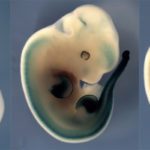Link to Pubmed [PMID] – 21206754
PLoS ONE 2010;5(12):e15741
Finding sequences that control expression of genes is central to understanding genome function. Previous studies have used evolutionary conservation as an indicator of regulatory potential. Here, we present a method for the unbiased in vivo screen of putative enhancers in large DNA regions, using the mouse as a model. We cloned a library of 142 overlapping fragments from a 200 kb-long murine BAC in a lentiviral vector expressing LacZ from a minimal promoter, and used the resulting vectors to infect fertilized murine oocytes. LacZ staining of E11 embryos obtained by first using the vectors in pools and then testing individual candidates led to the identification of 3 enhancers, only one of which shows significant evolutionary conservation. In situ hybridization and 3C/4C experiments suggest that this enhancer, which is active in the neural tube and posterior diencephalon, influences the expression of the Olig1 and/or Olig2 genes. This work provides a new approach for the large-scale in vivo screening of transcriptional regulatory sequences, and further demonstrates that evolutionary conservation alone seems too limiting a criterion for the identification of enhancers.

